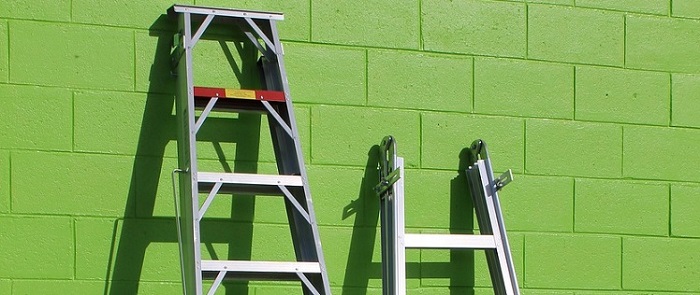18
Jun

It’s believed that ladders or at least the idea of them was first used over 10,000 years ago, based on drawings found in a cave in Spain . While these ladders were not as sophisticated as today’s steel ladders, they still did the same job – provided safe support to a higher level. A ladder is also mentioned in the Bible – in a dream Jacob saw a ladder going from heaven to earth. Ladders saw a step in the right direction in 1862 when John H. Basely invented the step ladder. This type of ladder had hinges on so it could be folded when there was not in use. While today there are still ladders being used that are made of rope, industrial ladders are the safer version.
These ladders are the most popular nowadays due to their portability and sturdiness. Step industrial ladders and steps are used in various industries but they can also be used for the purposes of household repairs. There are two types of step ladders: front step and twin step ladders.

source: safetyliftingear.com
Folding ladders are exactly what you expect them to be. Easy to store and extremely portable, these type of ladders are self-supporting while being able to withstand heavy loads. They are mainly used in households, but there are some folding ladders that include safety features worthy enough to be used in industrial settings.
Although these ladders can’t stand on their own without support, they can extend in order to provide access to a higher point. Extension ladders are the most versatile of the four. They work this way thanks to a part known as “fly” which moves along the base of the ladder in order to increase the length of the ladder.
With platform industrial ladders and steps you get a platform with a rail guard at the highest point of the ladder. Platform ladders are recommended for tasks that take long time to complete as these ladders are more convenient to use than the aforementioned ones.

source: steelfabservices.com.au
The working length of a ladder is the distance between its top support and its base. Safe work ladders should have their base sticking out about 30 cm and there should be a support level at every 1.2 m up to the ladder’s highest point (top support).
Using industrial ladders in a safe manner involves doing multiple things such as always facing the ladder when climbing up and down. Having a firm grip is also a must and you should use both hands to climb up and down. You should have the ladder close to your workspace in order to avoid pushing or pulling to the sides.
Avoid over reaching from the ladder – just move it when needed. Walking or jogging whilst on a ladder should also be avoided. Overloading is a big no-no too as well as climbing the ladder from the side unless it has sideways motion protection. Climbing from one ladder to another should be avoided as well as sitting, standing or climbing on a ladder top. A ladder shouldn’t be left set up and unattended and you shouldn’t be on a ladder in high winds or during a thunderstorm.
Before each use, ladders should be inspected to ensure that you are going to be climbing up a safe and sturdy support structure. Make sure all the joints, rivets, bolts and nuts are tight and feet, rungs and steps are safe to stand on. Rung locks, pulleys, ropes, spreaders and pail shelves should be inspected too. A ladder should be kept clean from dust, oil, grease, mud, wet paint, snow and other slippery materials which means that you should also have clean shoes on when climbing one. Otherwise, there is a higher risk for accidents to happen.
Storing ladders is best done in a dark and dry place hanged on racks positioned at intervals of about 1.8 to 2 meters so there is proper support. Avoid storing any materials on the ladders and when transporting ladders have them properly secured. Ladders should be stored clean without any foreign materials on them.
There should be a 3-point contact while you’re on a ladder. Two feet and at least one hand should always be on the ladder. This is in case if you’re carrying a tool in the other hand but you should wear a safety harness with the lanyard tied to a lifeline or a safe structure. You can break this 3-point contact only when you are reaching the ground or another stable surface.